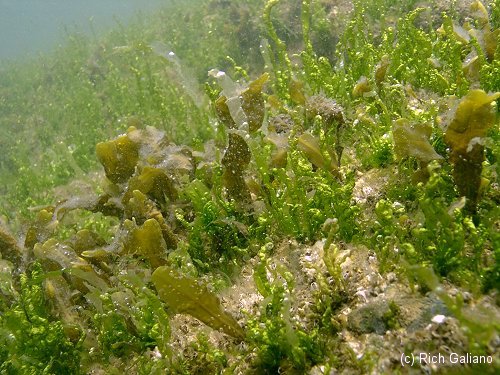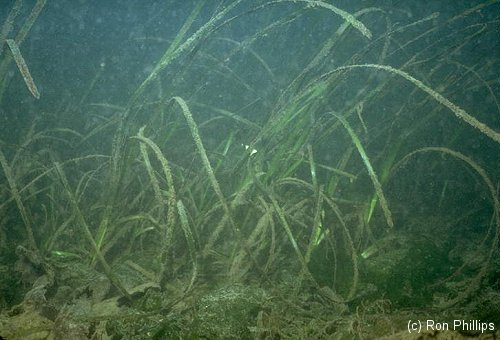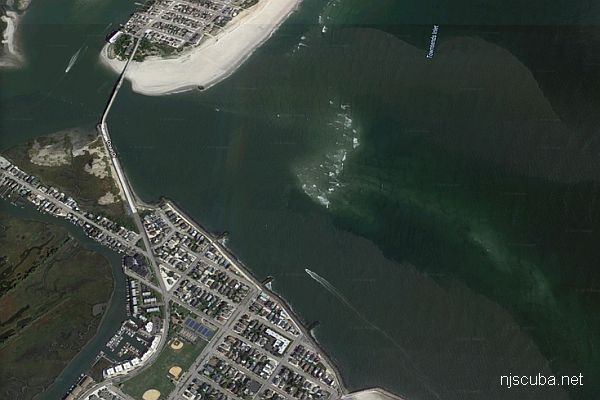Overview of Algae & Plants
Algae and plants are similar in that they can produce their own food from nutrients and sunlight by photosynthesis. The main difference between the two is in their complexity. Algae are simple organisms, sometimes unicellular, and even the largest types are relatively simple in structure. True plants, on the other hand, are quite complex, with many specialized structures, even in the smallest types.
Fungi are not plants, they do not produce their own food, but rather feed upon decaying matter. But neither are they animals, so I tacked them on here.
Algae
Algae is a large and diverse group of primarily aquatic plantlike organisms. These organisms were previously classified as a primitive subkingdom of the plant kingdom, the thallophytes: plants that lack true roots, stems, leaves, and flowers. More recently, most algae have been classified in the kingdom Protista or in another major group called the eukarya (or eukaryotes), which includes animals and higher plants. Algae have chlorophyll and can manufacture their own food through the process of photosynthesis. They are distributed worldwide in the sea, in freshwater, and in moist situations on land. Nearly all seaweeds are marine algae. Algae that thrive in polluted water, some of which are toxic, can overmultiply, resulting in an algal bloom and seriously unbalancing their ecosystem.

The simplest algae are single cells (e.g., the diatoms); the more complex forms consist of many cells grouped in a spherical colony (e.g., Volvox), in a ribbonlike filament (e.g., Spirogyra), or in a branching thallus form (e.g., Fucus). The cells of the colonies are generally similar, but some are differentiated for reproduction and for other functions. Kelps, the largest algae, may attain a length of more than 200 feet. Euglena and similar genera are free-swimming one-celled forms that contain chlorophyll but that are also able, under certain conditions, to ingest food in an animal-like manner. The green algae include most of the freshwater forms. The pond scum, a green slime found in stagnant water, is a green alga, as is the green film found on the bark of trees. The more complex brown algae and red algae are chiefly saltwater forms; the green color of the chlorophyll is masked by the presence of other pigments. Blue-green algae have been grouped with other prokaryotes in the kingdom Monera and renamed cyanobacteria.

Algae, the major food of fish (and thus indirectly of many other animals), are a keystone in the aquatic food chain of life; they are the primary producers of the food that provides the energy to power the whole system. They are also important to aquatic life in their capacity to supply oxygen through photosynthesis. Seaweeds, e.g., the kelps (kombu) and the red algae Porphyra (nori), have long been used as a source of food, especially in Asia. Both cultivated and naturally growing seaweeds have been harvested in the Pacific Basin for hundreds of years. Kelp is also much used as fertilizer, and kelp ash is used industrially for its potassium and sodium salts. Other useful algae products are agar and carrageen, which is used as a stabilizer in foods, cosmetics, and paints.
True Plants

A plant is any organism of the plant kingdom, as opposed to one of the animal kingdom or of the kingdoms Fungi, Protista, or Monera in the five-kingdom system of classification. ( A more recent system, suggested by genetic sequencing studies, places plants with animals and some other forms in an overarching group, the eukarya, to distinguish them from the prokaryotic bacteria and archaea, or ancient bacteria. ) A plant may be microscopic in size and simple in structure, as are certain one-celled algae, or a gigantic, many-celled complex system, such as a tree.
Plants are generally distinguished from animals in that they possess chlorophyll, are usually fixed in one place, have no nervous system or sensory organs and hence respond slowly to stimuli, and have rigid supporting cell walls containing cellulose. In addition, plants grow continually throughout life and have no maximum size or characteristic form in the adult, as do animals. In higher plants, the meristem tissues in the root and stem tips, in the buds, and in the cambium are areas of active growth. Plants also differ from animals in the internal structure of the cell and in certain details of reproduction.
There are exceptions to these basic differences: some unicellular plants ( e.g., Euglena ) and plant reproductive cells are motile; certain plants ( e.g., Mimosa pudica, the sensitive plant ) respond quickly to stimuli; and some lower plants do not have cellulose cell walls, while the animal tunicates ( e.g., the sea squirt ) do produce a cellulose-like substance.
The systems of classification of the plant kingdom vary in naming and placing the larger categories ( even the divisions ) because there is little reliable fossil evidence, as there is in the case of animals, to establish the true evolutionary relationships of and distances between these groups. However, comparisons of nucleic acid sequences in plants are now serving to clarify such relationships among plants as well as other organisms. A widely held view of plant evolution is that the ancestors of land plants were primitive algae that made their way from the ocean to freshwater, where they inhabited alternately wet-and-dry shoreline environments, eventually giving rise to such later forms as the mosses and ferns. From some remote fern ancestor, in turn, arose the seed plants.
The plant kingdom traditionally was divided into two large groups, or subkingdoms, based chiefly on the reproductive structure. These are the thallophytes (subkingdom Thallobionta), which do not form embryos, and the embryophytes (subkingdom Embryobionta), which do. All embryophytes and most thallophytes have a life cycle in which there are two alternating generations. The plant form of the thallophytes is an undifferentiated thallus lacking true roots, stems, and leaves. The subkingdom Thallobionta is composed of more than 10 divisions of algae and fungi (once considered plants). The subkingdom Embryobionta is composed of two groups: the bryophytes (liverwort and moss), division Bryophyta, which have no vascular tissues, and a group consisting of seven divisions of plants that do have vascular tissues. The Bryophyta, like other nonvascular plants, are simple in structure and lack true roots, stems, and leaves; they therefore usually live in moist places or in water.
The vascular plants have true roots, stems, and leaves and a well-developed vascular system composed of xylem and phloem for transporting water and food throughout the plant; they are therefore able to inhabit the land. Three of the divisions of the vascular plants are currently represented by only a very few species. They are the Psilotophyta, with only three living species; the Lycopodiophyta (club mosses); and the Equisetophyta (horsetails). All the plants of a fourth subdivision, the Rhyniophyta, are extinct. The remaining divisions include the dominant vegetation of the earth today: the ferns, the cone-bearing gymnosperms, and the angiosperms, or true flowering plants. The latter two classes, because they both bear seeds, are often collectively called spermatophytes, or seed plants.
The gymnosperms are all woody perennial plants and include several orders, of which most important are the conifer, the ginkgo, and the cycad. The angiosperms are separated into the monocotyledonous plants - usually with one cotyledon per seed, scattered vascular bundles in the stem, little or no cambium, and parallel veins in the leaf - and the dicotyledonous plants - which as a rule have two cotyledons per seed, cylindrical vascular bundles in a regular pattern, a cambium, and net-veined leaves. There are some 50,000 species of monocotyledon, including the grasses ( e.g., bamboo and such cereals as corn, rice, and wheat ), cattails, lilies, bananas, and orchids. The dicotyledons contain nearly 200,000 species of plant, from tiny herbs to great trees; this enormously varied group includes the majority of plants cultivated as ornamentals and for vegetables and fruit.
Plants are essential to the balance of nature and in people's lives. Green plants, i.e., those possessing chlorophyll, manufacture their own food and give off oxygen in the process called photosynthesis, in which water and carbon dioxide are combined by the energy of light. Plants are the ultimate source of food and metabolic energy for nearly all animals, which cannot manufacture their own food. Besides foods ( e.g., grains, fruits, and vegetables ), plant products vital to humans include wood and wood products, fibers, drugs, oils, latex, pigments, and resins. Coal and petroleum are fossil substances of plant origin. Thus plants provide people not only sustenance but shelter, clothing, medicines, fuels, and the raw materials from which innumerable other products are made.
Fungi
Fungi are a kingdom of heterotrophic single-celled, multinucleated, or multicellular organisms, including yeasts, molds, and mushrooms. The organisms live as parasites, symbionts, or saprophytes. Previously classified in the plant kingdom, fungi are nonmotile, like plants, but lack the vascular tissues ( phloem and xylem ) that form the true roots, stems, and leaves of plants. Most coenocytic (multinucleated) or multicellular fungi are composed of multiple filaments, called hyphae, grouped together into a discrete organism called a mycelium. The cell walls of fungi are of chitin or other noncellulose compounds. In many ways, fungi are more closely related to animals than to plants, and they have been thought to share a common protist ancestor with animals. A recent classification system suggested by nucleic acid ( genetic material ) comparisons places the fungi with the animals and the plants in an overarching taxonomic group called the eukarya.
Most fungi are capable of asexual and sexual reproduction. Asexual reproduction is by fragmentation or spore formation. Those that reproduce sexually produce gametes in specialized areas of the hyphae called gametangia. The gametes may be released to fuse into spores elsewhere, or the gametangia themselves may fuse. In some cases dikaryons [di = two, karyo = nucleus], which are found only among fungi, result when unspecialized hyphae fuse but their nuclei remain distinct for part of the life cycle.
Unlike algae or plants, fungi lack the chlorophyll necessary for photosynthesis and must therefore live as parasites or saprobes (see parasite). Typically they release digestive enzymes onto a food source, partially dissolving it to make the necessary organic or inorganic nutrients available. Some parasitic types obtain their food directly from the cells of a living food source. Some types of fungi are involved in symbiotic relationships, for example, lichens ( a combination of a fungus and a green alga or a cyanobacterium ) and the mycorrhizae ( symbiosis between a fungus and the roots of a vascular plant. )
Some fungi are pathogenic to humans and other animals. Such diseases are called mycoses or fungal infections. Some molds, in particular, release toxic chemicals called mycotoxins that can result in poisoning or death. Various fungi can also cause serious damage to fruit harvests and other crops.
Compiled from various sources

